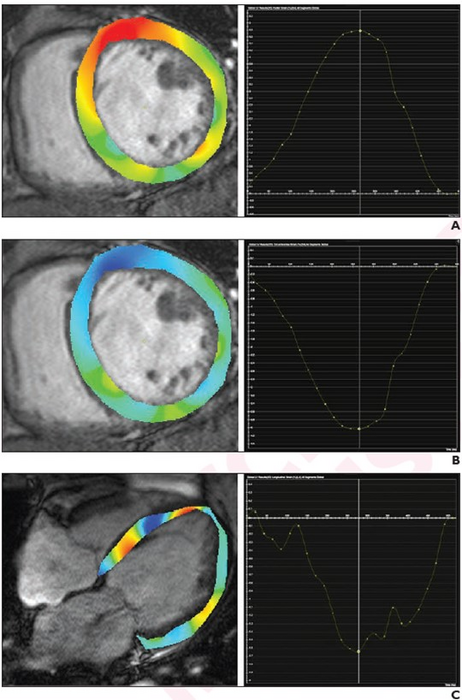Leesburg, VA, November 9, 2022—According to an accepted manuscript published in ARRS’ American Journal of Roentgenology (AJR), left ventricular global longitudinal strain—derived from feature tracking on cardiac MRI—is a significant independent predictor of adverse outcomes in patients with dilated cardiomyopathy.

Credit: ARRS/AJR
Leesburg, VA, November 9, 2022—According to an accepted manuscript published in ARRS’ American Journal of Roentgenology (AJR), left ventricular global longitudinal strain—derived from feature tracking on cardiac MRI—is a significant independent predictor of adverse outcomes in patients with dilated cardiomyopathy.
“This study strengthens the body of evidence supporting the clinical implementation of feature tracking when performing cardiac MRI in patients with dilated cardiomyopathy,” wrote corresponding author Dr. Ming-Yen Ng from the department of diagnostic radiology at the University of Hong Kong.
In this AJR accepted manuscript, 471 patients (365 men, 106 women; median age, 61 years) with ischemic (n=233) or nonischemic (n=238) dilated cardiomyopathy and left ventricular ejection fraction <50% underwent cardiac MRI at four centers from January 2011 to December 2019. Manual contouring helped to determine cardiac MRI parameters; additionally, software-based feature tracking was used to calculate six myocardial strain parameters: left ventricular (LV) and right ventricular (RV) global radial, global circumferential, and global longitudinal strain. Late gadolinium enhancement (LGE) was also evaluated.
Ultimately, in patients with dilated cardiomyopathy who underwent cardiac MRI with feature tracking, LV global longitudinal strain was a significant predictor of a composite outcome of all-cause mortality and/or heart-failure hospitalization (hazard ratio=1.13, p=.006), independent of age, corrected LV and RV end-diastolic volume, LV and RV ejection fraction, and presence of late gadolinium enhancement.
Noting that the literature has published conflicting results regarding the utility of cardiac MRI-derived feature tracking parameters, “this multicenter study supports the role of LV global longitudinal strain as a prognostic marker of adverse outcomes in patients with dilated cardiomyopathy,” the authors of this AJR accepted manuscript reiterated.
An electronic supplement to this AJR accepted manuscript is available here.
North America’s first radiological society, the American Roentgen Ray Society (ARRS) remains dedicated to the advancement of medicine through the profession of medical imaging and its allied sciences. An international forum for progress in radiology since the discovery of the x-ray, ARRS maintains its mission of improving health through a community committed to advancing knowledge and skills with the world’s longest continuously published radiology journal—American Journal of Roentgenology—the ARRS Annual Meeting, InPractice magazine, topical symposia, myriad multimedia educational materials, as well as awarding scholarships via The Roentgen Fund®.
MEDIA CONTACT:
Logan K. Young, PIO
44211 Slatestone Court
Leesburg, VA 20176
703-858-4332
Journal
American Journal of Roentgenology
DOI
10.2214/AJR.22.28415
Method of Research
Imaging analysis
Subject of Research
People
Article Title
Prognostic Utility of Cardiac MRI Myocardial Strain Parameters in Patients With Ischemic and Nonischemic Dilated Cardiomyopathy: A Multicenter Study
Article Publication Date
2-Nov-2022
COI Statement
Ming-Yen Ng has received educational grants from Circle Cardiovascular Imaging, Bayer, GE, TeraRecon, Arterys and Lode, as well as speakers fees from Boerhinger Ingelheim.




